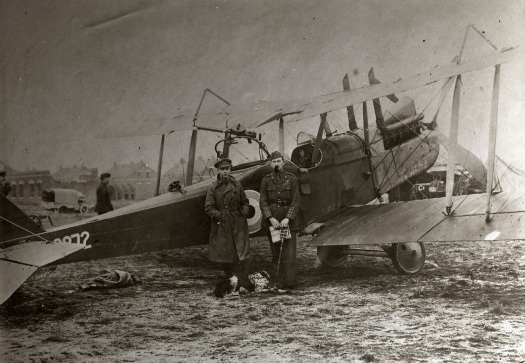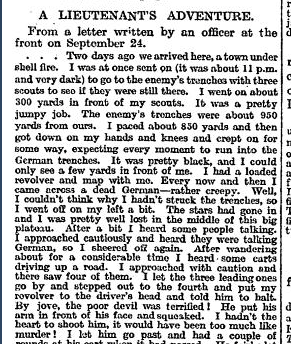In what would turn out to be Greg’s last successful shoot of the war, Capt. Cedric Foskett Gordon was Greg’s observer for the first time today. Captain Gordon was one of the senior officers of B Flight, 42 Squadron and was evidently a remarkable character.
Log Book

Date: 1.11.18 Time Out: 13.15 Rounds Fired – Lewis: - Rounds Fired – Vickers: - Bombs: - Time on RE8s: 185 hrs 10 mins RE8: 2407 Observer: Cpt. Gordon War Flying: 2 hrs 15 mins Height: 7000 Course/Remarks: Shoot Portuguese. Successful.
“Shoot Portuguese”
This is nothing to do with shooting Britain’s Portuguese allies, of course. Rather, it is everything to do with observing a shoot involving Portuguese artillery.
For reasons explained in yesterday’s post, no Squadron Record Book entry is available for today:
Because of that, we don’t know much about the shoot. The battery, though, was evidently one of the few remaining Portuguese artillery units. The Portuguese Expeditionary Corps had suffered badly on the first day of the Battle of the Lys, on 9 April 1918. As a result of this, by the end of the war Portugal had only nine artillery pieces left, according to the Passion and Compassion 1914-1918 website. Two of them were heavy howitzers: a British 6″ siege piece, and a similarly sized Franco-Portuguese 15 cm T.R. Schneider-Canet-du-Bocage. Given that Greg’s shoots tended to be with heavy (siege) artillery batteries, it was possibly that it was with these howitzers that he was observing and directing artillery fire today.
What might the target have been? We don’t know. Maybe it was one of the usual suspects: a hostile battery (Greg’s most frequent target), an ammunition dump, trenches, or a strategically important crossroads. Or it might have been something unusual, thrown up by the unprecedented circumstances in these last, heady days of the war. In any event, the target must have been east of the River Scheldt/Escaut, along which the British front line still ran in Greg’s sector. Some miles both to the north and and to the south of Tournai, though, further eastward progress had been made:

Captain Cedric Foskett Gordon MC, CdG
Greg’s observer today was Captain Gordon. Capt. Gordon was one of the two commanding officers of B Flight of 42 Squadron. He was evidently quite a character.
The following brief distillate of Capt. Gordon’s life comes, with permission, from Matt Ball’s informative Sevenoaks WW1 blog (see main link below or here):
Early Life and Wartime
Cedric Gordon was educated at Lancing College, were he excelled in sports. In 1910, he was commissioned into the North Staffordshire Regiment. He was sent to France on the outbreak of war and was wounded twice. In 1915 he was awarded the Military Cross for leading an attack on a village.
His second injury was the most serious and resulted in his losing a leg. You might be forgiven for thinking that this would be the end of his war service but Cedric joined the Royal Flying Corps and continued his wartime service as an observer and air gunner on the Western Front. He was subsequently awarded the Croix de Guerre in 1917, was mentioned in dispatches four times and awarded the military class of the OBE in 1919.
According to a nephew, quoted in his obituary, Cedric was shot at during one flight with the bullet shattering his wooden leg. On landing, he was said to have found the stray bullet in his pocket and was confined to bed until the camp carpenter had made him a new leg.
Post War
After the war, and having gained his pilot’s licence despite his wooden leg, Cedric was sent to Russia with British forces to aid the White Russians in the Crimea in their fight against the Bolsheviks. He was awarded the Distinguished Flying Cross and received the Order of St Ann and the Order of St Stanislas from the Russians. After leaving Russia, he flew in Palestine, where during one flight for reconnaissance work, he was forced to land in the desert and was, according to his obituary ‘picked up by a band of friendly Arabs’.
Cedric later worked for British intelligence in mainland China, before returning to England and taking command of the RAF Bloom Centre. During the Second World War, he was eventually put in charge of the South East Air Training Corps and was also a member of the Home Guard.
Retirement
On his retirement, he returned to Lancing College, where his brother Edward was a Master, to become Bursar. Later in life he became well known in Sevenoaks for his involvement in the local scouting movement.
The above comes from this post:
No doubt it was Capt. Gordon’s unusual circumstances that meant he was one of two officers in B Flight to hold the rank of Captain. The other was Capt. Bill Ledlie (of whom more here).
First Day Back
As it turns out, 1 November 1918 was Capt. Gordon’s first day back at the squadron at Ascq. For part of October he had been on leave in the UK. When he returned, he found that his dog (who rejoiced in the name of Waso) was missing. His own account of the day and the latter part of his journey back is preserved in a letter to his mother. This letter is one of a number kindly made available by Cedric Gordon’s nephew, Keith Gordon. As Matt Ball notes in another post on the Sevenoaks WW1 blog (see below, but also linked here):
What emerges from these letters is a strong sense of a close, spirited family, each with at least one nickname (Cedric’s was ‘beast’ owing to his general strength), and a spirit of adventure embodied by Cedric himself. No doubt some of his insouciance is designed to reassure his worried mother, to whom all of these letters are addressed…
With that as background, here is the text of Cedric Gordon’s letter of 1 November 1918:
All Saints Day (1 November) letter to darlingest Mother from 42 Squadron, RAF, BEF
I have arrived at last.
To go on where I left off. O’Keefe & I went & lunched at an estaminet where we had an excellent fish, some veal & a bottle of red wine, all of which made me far more contented with the world at large. This done, we returned to our vigil at the Town Mayor’s office & at about 3pm our Tender finally arrived. After a long & uneventful journey we arrived at the Squadron about 7pm.
Waso was reported missing, believed to have been stolen by a general belonging to the Corps. This was rather depressing, but the major who commanded 42 Sqn promised to take me round to the Corps with a view to returning my hound. I had dinner with HQ Mess & then went round to my Flight Mess (B Flight) & found them full of good cheer & beer. We had quite an amusing evening. I have got a very nice billet. There are quite a number (at present unknown) of French people living here. They have provided me with a very nice room upstairs & a large bed, sheets etc & a very small basin! The natives speak very bad French & I can’t make a great deal of headway with them, however they are very friendly.
This morning…
…I rose about 7.30am & sorted out my hut, such of it as hasn’t been lost during my absence. I spent the morning playing about with a Lewis gun & this afternoon I went up for a short time. This is an extraordinary safe job & no one gets hurt at it. So don’t you worry, dear old bird.
This evening…
…I went down with Hunter (the OC) to the Corps to interview this General man who had acquired Waso. I looked through the glass door & saw old Waz inside, so softly I opened the door & Waso came bounding out. She was awfully pleased to see me, almost as pleased as I was to see her. After a bit I got hold of the General who was a very nice fellow. He said he found her many miles away & had adopted her. I expect someone had picked her up in a lorry or some vehicle & dropped her off after a bit.
He was very loath to part with her & said he was very fond of her, which is not surprising. However, he gave her up & I promised him a puppy when the next instalment arrives, & we parted friends. Normally people go to bed here about 8.30pm, which is rather dull. They are, on the whole, a very comic crowd, but there are several very nice fellows.
I have missed you…
…most awfully. It is rotten leaving you, however before very long now the war will be over & Waso & I will return to the family. No more news at present. Very fondest love darlingest. Best love to Karf who, together with my old Mother, made my leave absolutely splendid. I hope Am is well. God bless you darlingest.
Photos
Greg had a few photos of Capt. Gordon in his collection. The two of them must have been in touch after the war, as that is evidently when at least a couple of the photos were taken. I’m grateful to Keith Gordon for his help with identifying the locations of the last two.




A Telling Tale
To get a further flavour of Cedric Gordon’s character, here is a link to Matt Ball’s second post on Cedric Gordon, which contains the text of several more letters. The last of the letters, dated 24 September, is worth reading in particular. It is about a scouting excursion on the ground beyond the lines.













































